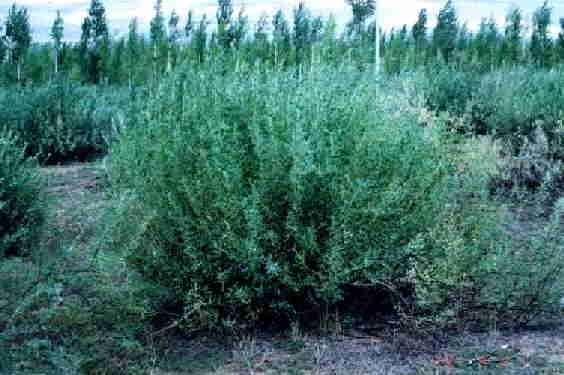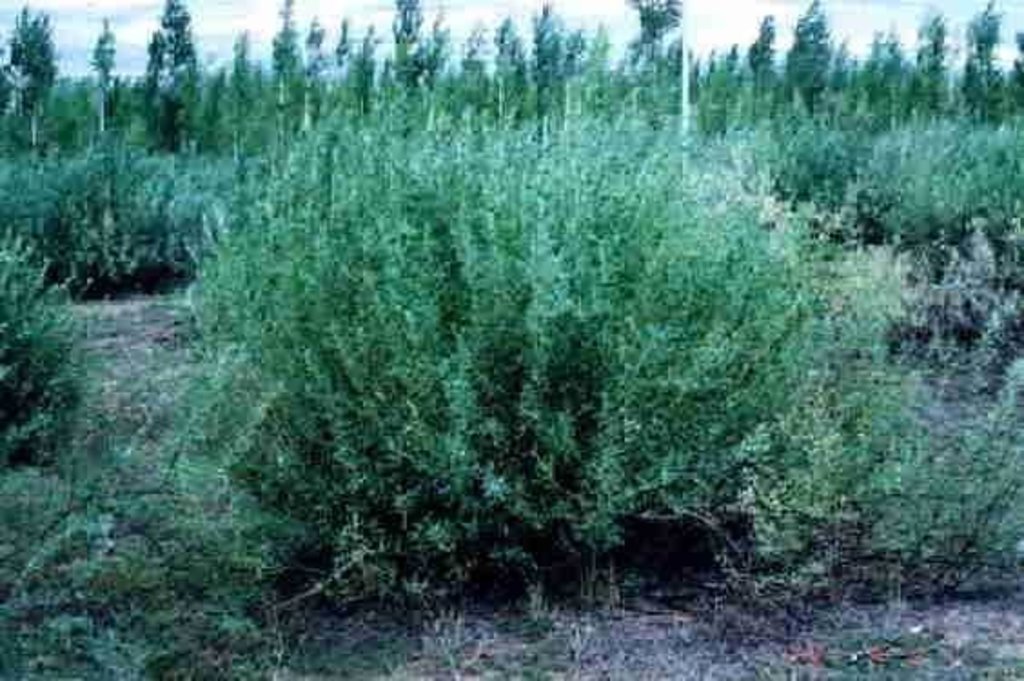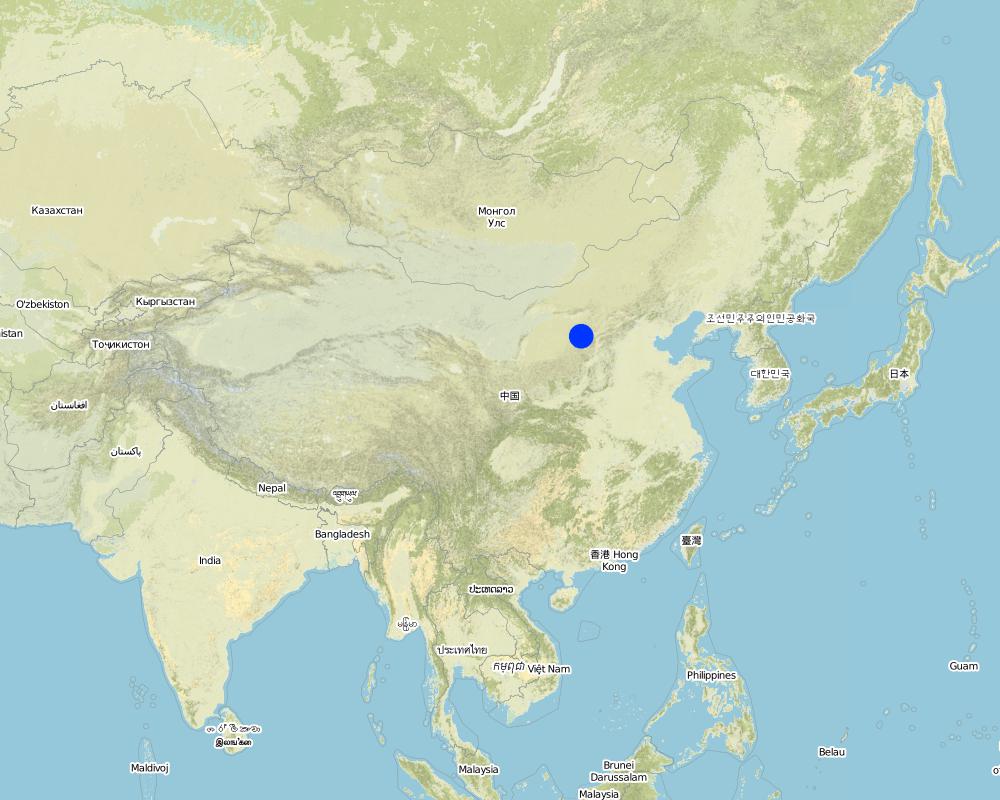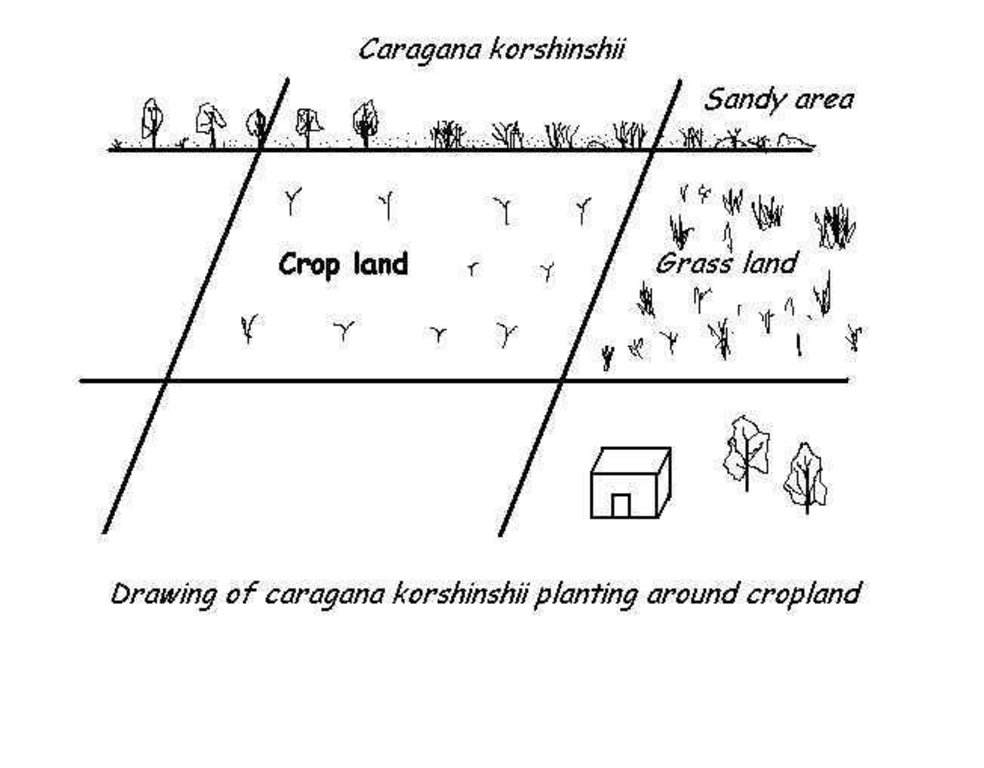Caragana Korshinskii Planting a kind of SWC vegetative technology [中国]
- 创建:
- 更新:
- 编制者: Jinsheng FU
- 编辑者: –
- 审查者: David Streiff, Alexandra Gavilano
Ning Tiao Planting
technologies_1370 - 中国
查看章节
全部展开 全部收起1. 一般信息
1.2 参与该技术评估和文件编制的资源人员和机构的联系方式
有助于对技术进行记录/评估的机构名称(如相关)
Department of Resources and Environmental Science, Beijing Normal University (Department of Resources and Environmental Science, Beijing Normal University) - 中国1.3 关于使用通过WOCAT记录的数据的条件
编制者和关键资源人员接受有关使用通过WOCAT记录数据的条件。:
是
1.5 参考关于SLM方法(使用WOCAT记录的SLM方法)的调查问卷
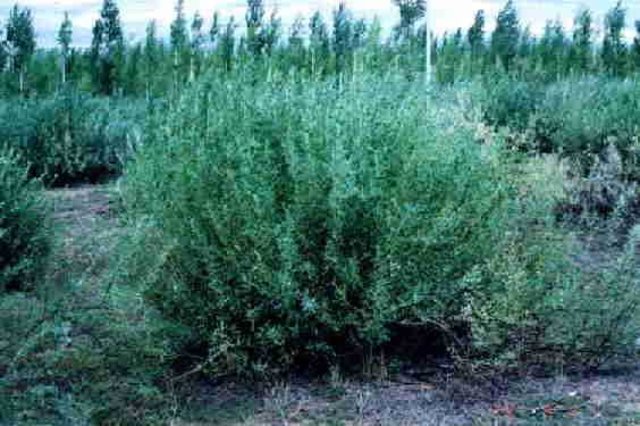
Caragana Korshinskii Planting - a SWC vegetation technology [中国]
SWC decision makers, I.e. approach planners, lead local people to plant caragana korshinskii in the areas of serious water and/or wind erosion by means of combined inputs from government, locals and social loan etc.
- 编制者: Jinsheng FU
2. SLM技术的说明
2.1 技术简介
技术定义:
Caragana korshinskii, a kind of perennial shrub, is used to protect soil from water and wind erosion, rhizobium in its root can increase soil fertility.
2.2 技术的详细说明
说明:
Caragana korshinskii is a kind of perennial and drought resistant shrub being used to protect soil from water and wind erosion. It has long roots in and can extract water from deep soil layers. Its roots with rhizobium can improve soil fertility. So caragana korshinskii can be planted where water and /or wind erosion is serious. Its branch has economic value. In autumn before raining, caragana korshinskii seeds are planted into holes. In the first three or four years, It should be protected from cutting and sheep eating. From the fourth year its branches are cut as fodder or fuel or to make paper, its seeds are collected for sale, flowers are used to breed bees, and so on.
2.3 技术照片
2.5 已应用该技术的、本评估所涵盖的国家/地区/地点
国家:
中国
区域/州/省:
Shanxi
具体说明该技术的分布:
- 均匀地分布在一个区域
如果技术均匀分布在一个区域,则指定覆盖的区域(单位为平方千米):
8362.4
如果不知道精确的区域,请注明大致覆盖的区域:
- 1,000-10,000 平方千米
注释:
Total area covered by the SLM Technology is 8362.4 km2.
Caragana korshinskii is one of most drought endurable shrubs. Once planted, it grows very fast.
Map
×2.6 实施日期
如果不知道确切的年份,请说明大概的日期:
- 不到10年前(最近)
2.7 技术介绍
详细说明该技术是如何引入的:
- 通过土地使用者的创新
注释(项目类型等):
Indigenous.
3. SLM技术的分类
3.1 该技术的主要目的
- 减少、预防、恢复土地退化
3.2 应用该技术的当前土地利用类型
同一土地单元内混合使用的土地::
是
具体说明混合土地使用(作物/放牧/树木):
- 农牧业(包括农牧结合)

农田
- 一年一作
- 多年一作(非木材)
年作 - 具体指明作物:
- 谷物类 - 玉米
- 根/块茎作物 - 土豆
- 蔬菜 - 叶菜(色拉、卷心菜、菠菜和其他)
- wheat
- Caragana korshinskii
每年的生长季节数:
- 2
具体说明:
Longest growing period in days: 160Longest growing period from month to month: Apr - Sep

牧场
注释:
Major land use problems (compiler’s opinion): Serious water and/or wind erosion, poor economic development and lack of SWC knowledge.
Major land use problems (land users’ perception): Combined wind and water erosion, low crop yield, inadequate humus in soils, steep slope land.
3.4 供水
该技术所应用土地的供水:
- 混合雨水灌溉
注释:
Water supply also rainfed
3.5 该技术所属的SLM组
- 防风林/防护林带
- 土壤肥力综合管理
3.6 包含该技术的可持续土地管理措施

植物措施
- V1:乔木和灌木覆盖层
3.7 该技术强调的主要土地退化类型

土壤水蚀
- Wt:表土流失/地表侵蚀
- Wg:冲沟侵蚀/沟蚀

土壤风蚀
- Et:表土流失

化学性土壤退化
- Cn:肥力下降和有机质含量下降(非侵蚀所致)

水质恶化
- Ha:干旱化
注释:
Main type of degradation addressed: Wt: loss of topsoil / surface erosion, Wg: gully erosion / gullying, Et: loss of topsoil, Cn: fertility decline and reduced organic matter content, Ha: aridification
Main causes of degradation: deforestation / removal of natural vegetation (incl. forest fires), over-exploitation of vegetation for domestic use, overgrazing, other human induced causes (specify) (Agricultural causes), land tenure (Land subdivision), poverty / wealth (Lack of captial), education, access to knowledge and support services (Lack of knowledge)
Secondary causes of degradation: labour availability (Lack of labour), Lack of enforcement of legislat./authority
3.8 防止、减少或恢复土地退化
具体数量名该技术与土地退化有关的目标:
- 适应土地退化
4. 技术规范、实施活动、投入和成本
4.1 该技术的技术图纸
技术规范(与技术图纸相关):
Drawing of caragana korshinskii applied in the north of the Loess Plateau.
Location: Pianguan. Shanxi
Date: 2002
Technical knowledge required for field staff / advisors: high
Technical knowledge required for land users: moderate
Main technical functions: control of raindrop splash, control of dispersed runoff: retain / trap, control of dispersed runoff: impede / retard, control of concentrated runoff: retain / trap, control of concentrated runoff: impede / retard, reduction of slope angle, reduction of slope length, improvement of ground cover, increase of surface roughness, increase in organic matter, increase of infiltration, increase / maintain water stored in soil, water harvesting / increase water supply, water spreading, reduction in wind speed, improvement of soil structure, increase in soil fertility
Trees/ shrubs species: Caragana korshinskii
Slope (which determines the spacing indicated above): 32.00%
If the original slope has changed as a result of the Technology, the slope today is (see figure below): 25.00%
Gradient along the rows / strips: 20.00%
作者:
BAI Zhanguo, Beijing China
4.2 有关投入和成本计算的一般信息
具体说明成本计算所用货币:
- 美元
注明雇用劳工的每日平均工资成本:
5.00
4.3 技术建立活动
| 活动 | 时间(季度) | |
|---|---|---|
| 1. | collecting seeds | July to August |
| 2. | digging holes | before raining in Autumn |
| 3. | seeding | before raining in Autumn |
| 4. | watering |
4.4 技术建立所需要的费用和投入
注释:
Duration of establishment phase: 36 month(s)
4.5 维护/经常性活动
| 活动 | 时间/频率 | |
|---|---|---|
| 1. | protecting young plants from sheep | In the first three years |
| 2. | cutting of branches | after four years /According to utilization |
| 3. | protecting young from insects | from florescence /annual |
4.6 维护/经常性活动所需要的费用和投入(每年)
注释:
planting density, slope gradient and length, SWC area.
4.7 影响成本的最重要因素
描述影响成本的最决定性因素:
manual labor, maintenance of young plants in the first 3-4 years.
5. 自然和人文环境
5.1 气候
年降雨量
- < 250毫米
- 251-500毫米
- 501-750毫米
- 751-1,000毫米
- 1,001-1,500毫米
- 1,501-2,000毫米
- 2,001-3,000毫米
- 3,001-4,000毫米
- > 4,000毫米
有关降雨的规范/注释:
350~550mm in loess plateau mainly from June to September
农业气候带
- 半湿润
- 半干旱
5.2 地形
平均坡度:
- 水平(0-2%)
- 缓降(3-5%)
- 平缓(6-10%)
- 滚坡(11-15%)
- 崎岖(16-30%)
- 陡峭(31-60%)
- 非常陡峭(>60%)
地形:
- 高原/平原
- 山脊
- 山坡
- 山地斜坡
- 麓坡
- 谷底
垂直分布带:
- 0-100 m a.s.l.
- 101-500 m a.s.l.
- 501-1,000 m a.s.l.
- 1,001-1,500 m a.s.l.
- 1,501-2,000 m a.s.l.
- 2,001-2,500 m a.s.l.
- 2,501-3,000 m a.s.l.
- 3,001-4,000 m a.s.l.
- > 4,000 m a.s.l.
说明该技术是否专门应用于:
- 不相关
关于地形的注释和进一步规范:
Landforms also hill slopes
5.3 土壤
平均土层深度:
- 非常浅(0-20厘米)
- 浅(21-50厘米)
- 中等深度(51-80厘米)
- 深(81-120厘米)
- 非常深(> 120厘米)
土壤质地(表土):
- 粗粒/轻(砂质)
- 中粒(壤土、粉土)
表土有机质:
- 低(<1%)
如有可能,附上完整的土壤描述或具体说明可用的信息,例如土壤类型、土壤酸碱度、阳离子交换能力、氮、盐度等。:
Soil fertility: low - medium
Soil drainage / infiltration: good
Soil water storage capacity: low
5.6 应用该技术的土地使用者的特征
非农收入:
- 收入的10-50%
相对财富水平:
- 平均水平
机械化水平:
- 手工作业
- 畜力牵引
说明土地使用者的其他有关特征:
Population density: 100-200 persons/km2
Annual population growth: < 0.5%
20% of the land users are very rich (>1000).
14% of the land users are rich (800~1000).
49% of the land users are average wealthy (400~800).
14% of the land users are poor (200~400).
3% of the land users are poor (<200).
Off-farm income specification: The land users who applied the SWC technology can feed much more cattle, sheep and goat etc than those who do not take the SWC measure.
5.8 土地所有权、土地使用权和水使用权
土地所有权:
- 州
土地使用权:
- 社区(有组织)
- 个人
6. 影响和结论性说明
6.1 该技术的现场影响
生态影响
水循环/径流
地表径流
SLM之前的数量:
10
SLM之后的数量:
2
土壤
土壤流失
SLM之前的数量:
170
SLM之后的数量:
75
6.4 成本效益分析
技术收益与技术建立成本相比如何(从土地使用者的角度看)?
短期回报:
轻度消极
长期回报:
非常积极
技术收益与技术维护成本/经常性成本相比如何(从土地使用者的角度看)?
短期回报:
轻度消极
长期回报:
非常积极
6.5 技术采用
- > 50%
如若可行,进行量化(住户数量和/或覆盖面积):
167250 households
在所有采用这项技术的人当中,有多少人是自发的,即未获得任何物质奖励/付款?:
- 0-10%
注释:
100% of land user families have adopted the Technology with external material support
167250 land user families have adopted the Technology with external material support
Comments on acceptance with external material support: estimates
Comments on spontaneous adoption: estimates
There is a moderate trend towards spontaneous adoption of the Technology
Comments on adoption trend: More and more people become to know the importance of protection environment. More and more people get to recognize the economic value of planting caragana korshinskii.
7. 参考和链接
7.1 信息的方法/来源
7.2 参考可用出版物
标题、作者、年份、ISBN:
Li Jinchuan, Wang Wenying, Lu Chongen. Exploration on Restoring Vegetations of Dump Land on An-Tai-Bao Surface Mine.. 1999.
可以从哪里获得?成本如何?
Henan Science.17(Suppl.): 92-95.
标题、作者、年份、ISBN:
Bai Yongqiang. Studies on Phenological Patterns of the Main Shrubs in Yanchi Sandy Land.. 1998.
可以从哪里获得?成本如何?
Journal of Arid land Resources and Environment. 12(2): 82-86.
标题、作者、年份、ISBN:
Yang Wenbin, Ren Jianmin, Jia Cuiping. Studies of The Relationship Between Physiological Ecology of Drought-Resist in Caragana Korshinskii and Soil Water.. 1997.
可以从哪里获得?成本如何?
Acta Ecologica Sinica. 17(3): 239-244.
标题、作者、年份、ISBN:
u Xuewen. Visible benefits of developing Caragana korshinskii in Pianguan county.. 1987.
可以从哪里获得?成本如何?
Economic benefits corpus of soil and water conservation, 10: 43-44.
标题、作者、年份、ISBN:
Li Zhirong. To advocate for Caragana korshinskii.. 1987.
可以从哪里获得?成本如何?
Economic benefits corpus of soil and water conservation. 10: 36-38.
标题、作者、年份、ISBN:
Zhao Zhizhong. Planting Caragana korshinskii extensively, breeding livestock to reach richness.. 1997.
可以从哪里获得?成本如何?
oil and Water Conservation Science and Technology in Shanxi..3: 26-28.
标题、作者、年份、ISBN:
Niu Xiwu. The distribution and description of Caragana Fabr. In China.. 1999.
可以从哪里获得?成本如何?
Acta Bot. Boreal. Accident Sin. 19(5): 107-133.
标题、作者、年份、ISBN:
Pan Ming, Zhao Jinrong. Benefits of Caragana korshinskii and its planting technology.. 1987.
可以从哪里获得?成本如何?
Economic benefits corpus of soil and water conservation. 10:39-42.
标题、作者、年份、ISBN:
Cheng Jimin. The Reasonable Utilization and Patterns of the Main Shrub Species In Southern Ningxia Hui Autonomous Region.. 1991.
可以从哪里获得?成本如何?
Bulletin of Soil and Water Conservation. 11(1): 54-61.
标题、作者、年份、ISBN:
Li Zizhen, Huan Zitan, Zhang Liping. Comprehensive Judgment of Sandfixing Benefits of Plants in the Ecological engineering of Sand Management.. 1997.
可以从哪里获得?成本如何?
Journal of Lanzhou Univ.(Social Science). 25(4): 40-47.
链接和模块
全部展开 全部收起链接

Caragana Korshinskii Planting - a SWC vegetation technology [中国]
SWC decision makers, I.e. approach planners, lead local people to plant caragana korshinskii in the areas of serious water and/or wind erosion by means of combined inputs from government, locals and social loan etc.
- 编制者: Jinsheng FU
模块
无模块


